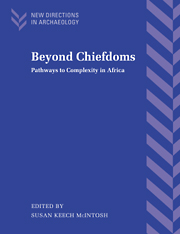Book contents
- Frontmatter
- Contents
- List of figures
- List of tables
- List of contributors
- Preface
- 1 Pathways to complexity: an African perspective
- 2 The segmentary state and the ritual phase in political economy
- 3 Perceiving variability in time and space: the evolutionary mapping of African societies
- 4 Western representations of urbanism and invisible African towns
- 5 Modeling political organization in large-scale settlement clusters: a case study from the Inland Niger Delta
- 6 Sacred centers and urbanization in West Central Africa
- 7 Permutations in patrimonialism and populism: The Aghem chiefdoms of Western Cameroon
- 8 Wonderful society: the Burgess Shale creatures, Mandara polities, and the nature of prehistory
- 9 Material culture and the dialectics of identity in the Kalahari: AD 700–1700
- 10 Seeking and keeping power in Bunyoro-Kitara, Uganda
- 11 The (in)visible roots of Bunyoro-Kitara and Buganda in the Lakes region: AD 800–1300
- 12 The power of symbols and the symbols of power through time: probing the Luba past
- 13 Pathways of political development in equatorial Africa and neo-evolutionary theory
- Index
5 - Modeling political organization in large-scale settlement clusters: a case study from the Inland Niger Delta
Published online by Cambridge University Press: 14 October 2009
- Frontmatter
- Contents
- List of figures
- List of tables
- List of contributors
- Preface
- 1 Pathways to complexity: an African perspective
- 2 The segmentary state and the ritual phase in political economy
- 3 Perceiving variability in time and space: the evolutionary mapping of African societies
- 4 Western representations of urbanism and invisible African towns
- 5 Modeling political organization in large-scale settlement clusters: a case study from the Inland Niger Delta
- 6 Sacred centers and urbanization in West Central Africa
- 7 Permutations in patrimonialism and populism: The Aghem chiefdoms of Western Cameroon
- 8 Wonderful society: the Burgess Shale creatures, Mandara polities, and the nature of prehistory
- 9 Material culture and the dialectics of identity in the Kalahari: AD 700–1700
- 10 Seeking and keeping power in Bunyoro-Kitara, Uganda
- 11 The (in)visible roots of Bunyoro-Kitara and Buganda in the Lakes region: AD 800–1300
- 12 The power of symbols and the symbols of power through time: probing the Luba past
- 13 Pathways of political development in equatorial Africa and neo-evolutionary theory
- Index
Summary
In the Western popular imagination, sub-Saharan Africa has long been the domain of small-scale, dispersed, mobile, swidden agriculturalists. Yet within the Inland Niger Delta in the Sudanic zone of West Africa, some of the earliest documented agricultural communities display quite the opposite pattern: rapid population growth over the course of centuries-long occupation of high density settlement clusters. Commonly, a cluster comprises a large, central settlement mound of up to 10 meters in height and 20–80 hectares in area, surrounded by intermediate and smaller mounds at distances of 200 meters or less. In the vicinity of Jenné-jeno, where multiple clusters are present and there is evidence from survey and excavation for the extent of occupational contemporaneity among the various mounds, the total occupied mound surface exceeded 100 hectares within a millennium of the initial pioneering settlement c.250 BC. From a comparative perspective, the lengthy occupation sequences and the pattern and scale of population nucleation documented in the Inland Delta are relevant to a number of long-standing theoretical discussions in archaeology, among them the relation of population growth and the evolution of agricultural systems, and the relation of population size and political hierarchy. In this case study, both the lack of evidence for agricultural intensification and the distinctive pattern of nucleated settlement clusters are considered essential elements for understanding the particular trajectory that developing complexity assumed in the region.
Colonization and settlement clustering in the Inland Niger Delta
The Inland Niger Delta (IND), as its name implies, is an area of false deltaic hydrology located in the heart of the modern state of Mali over 1,500 km inland from any sea coast.
- Type
- Chapter
- Information
- Beyond ChiefdomsPathways to Complexity in Africa, pp. 66 - 79Publisher: Cambridge University PressPrint publication year: 1999
- 22
- Cited by



